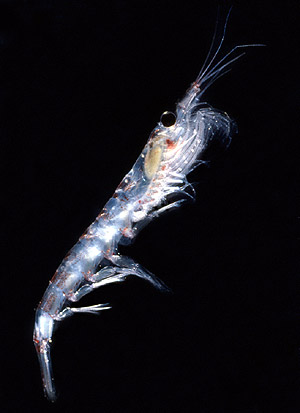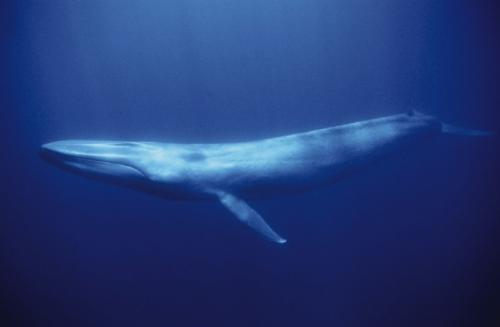Wednesday, May 28, 2008
FOOD & FEEDING:
*Shallow feeders
*Preferred food appears to be krill
*Adult blue whale may up to 8 tons of krill in a day
*Feeding takes place during the evening and early morning
Blue Whale Statistics
Adult weight: 200 tonnes max. / 110-120 tonnes average
Life span: 90 years
Sexual maturity: uncertain estimated at 5 - 15 years
Gestation: 10-11 months
Birth length: 6-7m (20-23ft)
Birth weight: 3.3 tonnes
Dive duration: 30 mins
Distribution: worldwide, but separated into distinct stocks
Current world population: up to 12,000 / pre-whaling - 200,000, maybe 300,00
Monday, May 19, 2008
Tuesday, May 13, 2008

HOW DO WHALES BREATH?
A whale's "nostrils" are called blowholes and are on the top of its head. Some whales have one blowhole and others, like this blue whale, have two. Unlike humans, whales breathe voluntarily. That means they choose when to take a breath. This is important because whales can't breathe underwater. They surface every few minutes to blow out a mixture of water and air and take in a breath of fresh air.
Everything about the blue whale is enormous. It is the largest animal on earth, ever. A big blue whale can be 100 feet long and weigh up to 150 tons. That's as large as a Boeing jet. Its heart is as large as a small car. Fifty people could stand on its tongue. Its spout shoots up at least 30 feet when it surfaces for air.
Monday, May 12, 2008
Blue Whales

The Feeding Of The Blue Whale
The blue whale is thought to feed almost exclusively on small, shrimp-like creatures called euphausiids or krill. During the summer feeding season the blue whale gorges itself, consuming an astounding 4 tons (3.6 metric tons) or more each day. This means it may eat up to 40 million krill a day. As a baleen whale, it has a series of 260-400 fringed overlapping plates hanging from each side of the upper jaw, where teeth might otherwise be located. These plates consist of a fingernail-like material called keratin that frays out into fine hairs on the ends inside the mouth near the tongue. The plates are black and measure about 20 inches (51 cm) in length toward the front of the mouth and about 40 inches (102 cm) at the rear. During feeding, large volumes of water and food can be taken into the mouth because the pleated grooves in the throat expand. As the mouth closes water is expelled through the baleen plates, which trap the food on the inside near the tongue to be swallo
Sunday, May 11, 2008

Blue whales are carnivores, although they only eat very tiny things, no bigger than your pinky finger. Their favorite food is krill, or shrimp-like euphausiids, that are up to three inches long. Blue whales must eat two to four tons of krill a day during the feeding season to survive the rest of the year. They concentrate on feeding during the polar summers primarily around the Channel Islands, Monterey Bay, and the Farallon Islands/Cordell Bank. During the winter months, they migrate to the warmer waters in Mexico and Costa Rica.
The blue whale usually feeds at depths of less than 100 m (330').
Blue whales feed almost exclusively on shrimplike crustaceans known as "krill". A blue whale may consume up to 5.5 - 6.4 metric tons (6 - 7 tons) of food per day during the summer feeding season. That's 7,715 pounds of krill (small shrimp-like organisms) per day! During the other 8 months of the year, it apparently doesn't eat anything, living off of stored fat.
The blue whale has long, flexible throat grooves. It feeds by using these groves to expand its throat and drawing in water laden with prey, then forcing the water out through its baleen plates. These plates filter out the prey organisms, which the whale then swallows.
Infomation
Friday, May 9, 2008
Status:Endangered
Population: Estimated between 1,300 to 2,000, the population of blue whales is dangerously low.
Threats:Blue whales face threats from entanglement in fishing nets, pollution, and illegal whaling.
Survival:The lifespan of a blue whale is estimated to be 80 years.
Blue whales are found throughout the world's oceans. These gentle giants have grayish-blue skin with light spots. Measuring 70 to 80 feet in length (the longest recorded length was 106 feet), blue whales can weigh as much as 90 to 150 tons, although females are larger than the males.
Blue whales generally spend winters in temperate and subtropical zones, migrating toward the polar regions in spring and summer. They swim 14 miles per hour (with bursts as fast as 30 mph) and feed at depths of less than 330 feet (but can dive as deep as 1,640 feet). Dives last from 10 to 20 minutes. Usually they travel alone or in small groups of two to four, although off the coast of California some groups as large as 60 have been seen.
Blue whales have about 300 to 400 baleen plates instead of teeth which they use to strain food from the ocean water. A blue whale can eat up to 7,715 pounds of krill (small shrimp-like organisms) per day!
Blue whales were once considered too difficult to hunt because of their speed and tremendous size. However, with the introduction of factory ships and the harpoon gun in the 1920s, blue whales were hunted intensively. By the 1960s they were nearly extinct.
The blue whale is one of the rorquals, a family that also includes the humpback whale, fin whale, Bryde's whale, sei whale, and minke whale. On land an animal the size of a blue whale would be crushed by its own weight without the support of large heavy bones. Because its body is supported by water, as a sea animal, the need for heavy bones to support its weight disappeared. This, plus the availability of a large food supply, have made it possible for the blue whale to reach such an enormous size. The blue whale makes deep and rumbling sounds which can be felt as much as heard. These low-frequency sounds travel long distances through water, allowing blue whales to communicate with each other over hundreds of miles of ocean.



